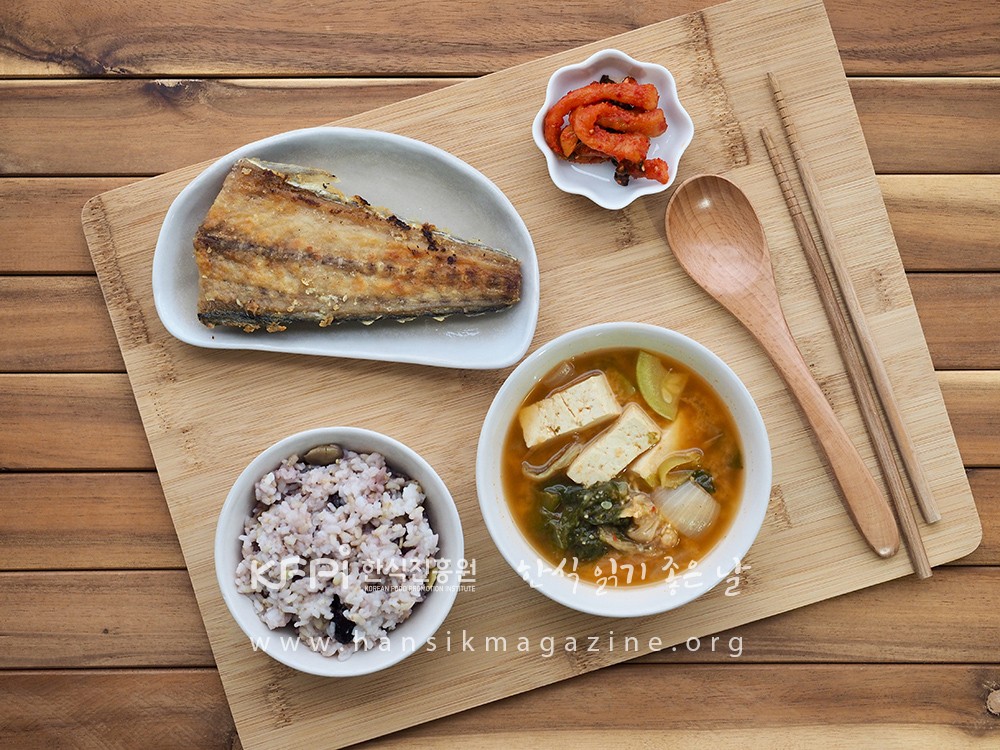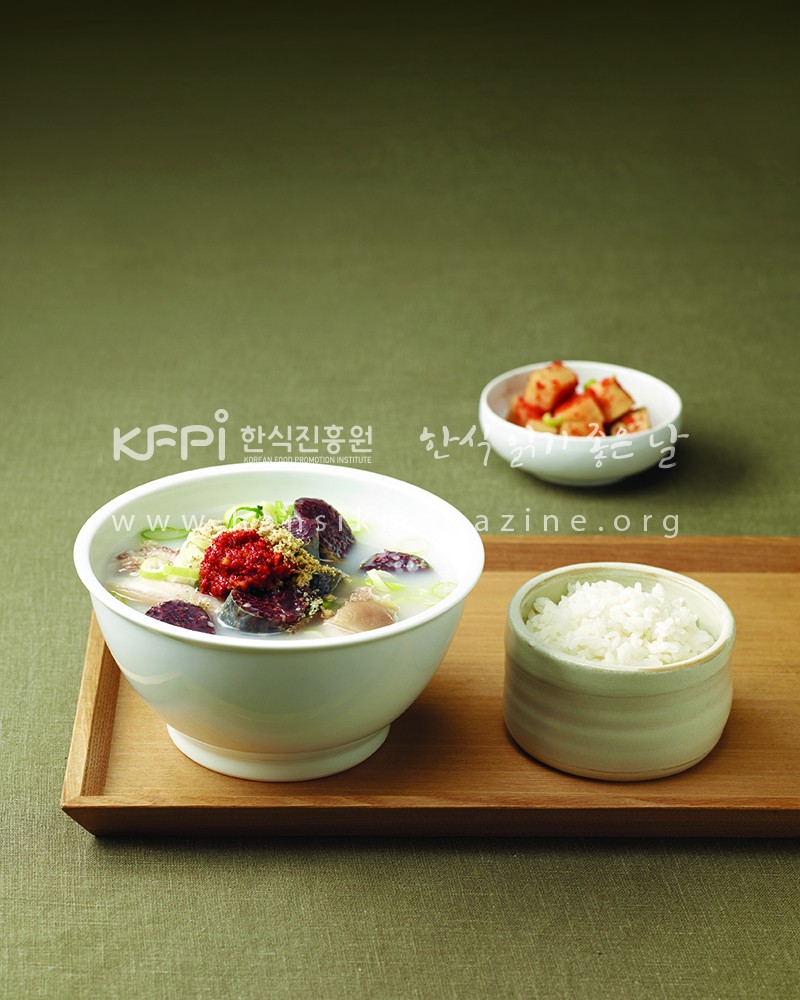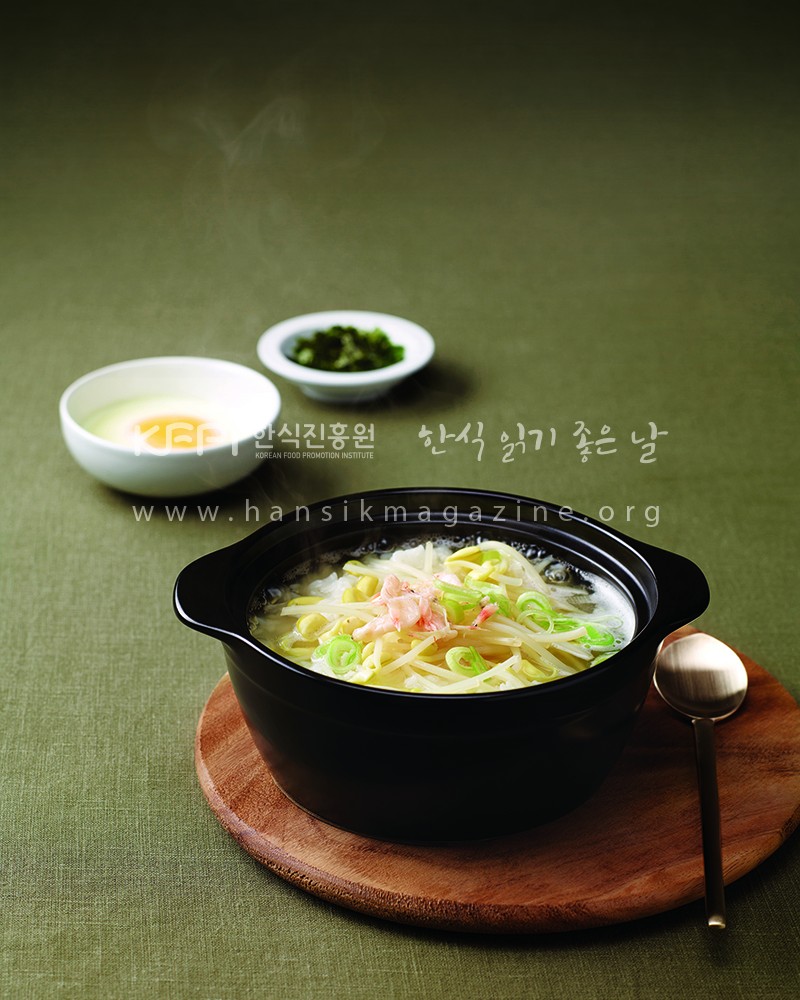한식 읽기 좋은 날
Vol 34. Dorumuk - Gangwon-do
Guk and Jjigae, that's the question
Listen to the expert
Hansik glossary
Guk/Tanf - soup
Jjigae - stew
Jeongol - hot pot
Written by Han Seongwoo(Professor, Department of Korean Language and Literature, Inha University)
If you believe that table setting must be follow the principle of "left rice, right soup," or believe there must be a spoon when eating, and are desperate for spicy soup in the morning during a long overseas trip, you must be Korean. If you know the thing on the right side of the rice contained in a bowl with the harmony of broth and solid stuff, the thing which is expressed to be 'cool' while eating boiling. It is the thing called Guk(soup), Tang(soup), jjigae(stew), jeongol(hot pot), etc. They are believed to be indispensable to the Korean's table, so everyone knows, but if you look at them one by one, there are countless questions.

Broth or solid stuff, that's the question
Foods called these names should have proper broth and a sold stuff, and if it has only broth, it looks like that someone has left it, and if it has only solid stuff, it looks like the soup are boiled down too much. The broth should be delicious, but it is boring if there is no solid stuff. And the broth may be made separately by meat stock or vegetable stock but there should be broth from the solid stuff itself. It often named after the solid stuff but it is called a perfect name if it is soaked in broth, so it won't end.
That's true in the words that we use. "There is no broth" is a word that raises the level of the solid stuff. This word used when people have done something by expecting something, and there's nothing to come back or gain. The expression of 'even broth' may mean focusing on the solid stuff. The word of 'there is no solid stuff to say' is also funny. At this time, 'the solid stuff' can be changed with 'thing' which can be interpreted 'ingredient'. If there is no solid stuff, there is no ingredients, which can't make soup. The preference between broth and solid stuff is the problem of taste. However, above all, the broth and the solid stuff make up the soup, so there is no more stuff to say that eating generously is to eating with broth.
Separately or together, that's the question.
Originally, soup and rice are served separately. They are served separately in different bowls and eaten alternately, so they are separate by nature. However, at some point while eating, people scoop plenty of white rice and put it in soup. It can save you from the trouble of having to switch your spoon between each food, but it's also serves a double purpose because you can taste both rice and soup at the same time. It appears in the busy marketplace under the name 'Gukbab(soup-rice)'. As the name suggests, rice and soup are served in one bowl. When people are busy, it's perfectly good because it can fill the hungry stomach and make the stomach comfortable at the same time. In the meantime, 'ttarogukbap(separate soup-rice)' appears. What was originally two became one and then became two again.
Soup in the days of rice and soup is the supporting role of rice. It is also an auxiliary food to make the rice slide down on the 'Bapsang' where the name itself is rice table." When they meet under the name of Gukbab', they become co-main characters. Koreans who can not give up rice for meals can't give up the soup even if they give up other side dishes. Although a rice bowl contains a piece of rice, the two must be harmonized to compete side by side, but in terms of ttarogukbap, the soup will become the main character. Rice is served naturally, so what ingredients you boiled soup decides the victory and defeat of this food.


Hot or cool, that's the question.
Depending on the food, people eat cold food and hot food in the manner it should be, but this food is too hot. It should be boiled until the family sits around the table and served hot. Moreover, it is served in the earthenware in which the heat is preserved well, making bubbling sound even in the table. In severe cases, picking up with iron tongs that look like the boiling water of hell and place it on a stand to prevent the table from burning. No, Korean invention "Burusta" is placed in the middle of the table and boil it until the end. Even in a busy market, they make gukbap by repeatedly putting broth in a earthen pot several times and spilling it out. Hotness is the life of this food.
But this food should be 'cool'. It is said to be cool when the hot broth attacks the tongue and palate and goes down the esophagus. It is said to be cool when it passes through the esophagus and reaches the stomach by adding a lot of red pepper powder. It's like that saying quietly shouting while soaking in a hot water that's higher than body temperature. It is an expression that can never be established in common sense, but Koreans know the meaning of this word and use it. Those who have stayed in Korea for a long time and have become accustomed to Korean food and life in Korea will use this word at last. You must be able to express it with your mouth after experiencing the true meaning of this word with your body to be a perfect Korean.
Where is a boundary? that's the question
Even Koreans who know the hot but cool taste have question that cannot be solved forever. The ingredients contained such as Kimchi, dubu(bean curd), pork are the same, but the name of the food is Guk(soup), jjigae(stew), jeongol(hot pot), and tang(soup). "Guk" is originally soup, so we can no longer analyze it, but "jjigae" comes from "jjida(steam)." Steamed dishes can't produce the broth because of the method of cooking with steam. Thus, although it originated from "jjida," the actual food has become far from the original meaning of the word. In addition, it is unclear whether the word jjigae was a word or food which existed originally. Not only does it not appear in the old literature, but there is no word jjigae depending on the region, and it is also called Guk only.
Thing gets more complex if jeongol and tang are commented. Jeongol was not used in the past, and the origin was unclear. It looks like a Chinese character and used to be written 煎骨 but the meaning is not easily understandable even if you try to analyze each meaning of the Chinese characters. On the other hand, 'tang' is from Chinese characters, so its origin is clear. But it is too wide. Tang in Seolleungtang(ox bone soup) seems to be used with the meaning of guk, in terms of Maeuntang(spicy fish stew), it is used in the same meaning as jjigae. After all, there is no answer and the boundary is obscure. When it is made of the same material, but if there is a lot of broth, it is Guk, or if not, it is jjigae. If you eat the same food at a high-end restaurant by paying lots of money, it is jeongol, and if you want to have old feeling, it is Tang.

Jung(affection) or soul? that's the question.
People need broth for every meal, but the time you miss the spicy broth so much is when you suffer from the hangover on the next day after drinking too much. Foods that are believed to be eaten on a day like this are called haejangguk(hangover soup). The main ingredients are various, with the name of dried pollack, seonji, and bean sprouts in front of them, but the purpose of this food is to remove the hangover on the previous day. But the main problem is whether it is the stomach or the head. That's because the liquor which is happy when drinking, but it is poisonous if it is too much, leaves a terrible headache on the head and a terrible stomachache on the stomach.
Guk is a native language, but 'haejang' seems to be a Chinese character. The first thing that comes to mind with short Chinese characters ability is the meaning of Haejang 解帳, that is ‘to relieve the intestine.’ This expression is reasonable because you feel your intestine and stomach relieved when you eat one spoon of hot haejangguk. But, it is not true. Haejang is originally Haejeong 解酲. A difficult Chinese character Jeong 酲 means hangover, so it means the guk relieving hangover. Therefore, if haejeong is the original word of haejang, it feels like Haejeong meaning of organizing entangled spirit. Because the symptoms of hangover are shown in the stomach and head, it would be the expression of desperate mind which want to relieve this.
You need rice to have guk. This also applies for left rice right soup, and gukbap and ttarogukbap. If there is bread, there is no guk, but soup instead. Rice and guk go well together on Korean food table, but it seems to be bread and soup seems to go well with western food table. The jjigae where people become a family and share it with their own spoon, is constantly criticized for its hygiene problems. The guk and jjigae may disappear with the passage of time. But until you suddenly want to feel cool with the hot broth in the morning, you will still need guk and jjigae.
Jeong Eun Jeong
Majored in rural and agricultural sociology, and is teaching and learning rural society and food industrialization at university.
Her books include <Korean Chicken Story> and <Sowing Seeds on Asphalt-Records of Paik Namki Farmers' Struggle> etc.










